
How psychology works the facts visually explained (DK) (Z-Library)
.pdf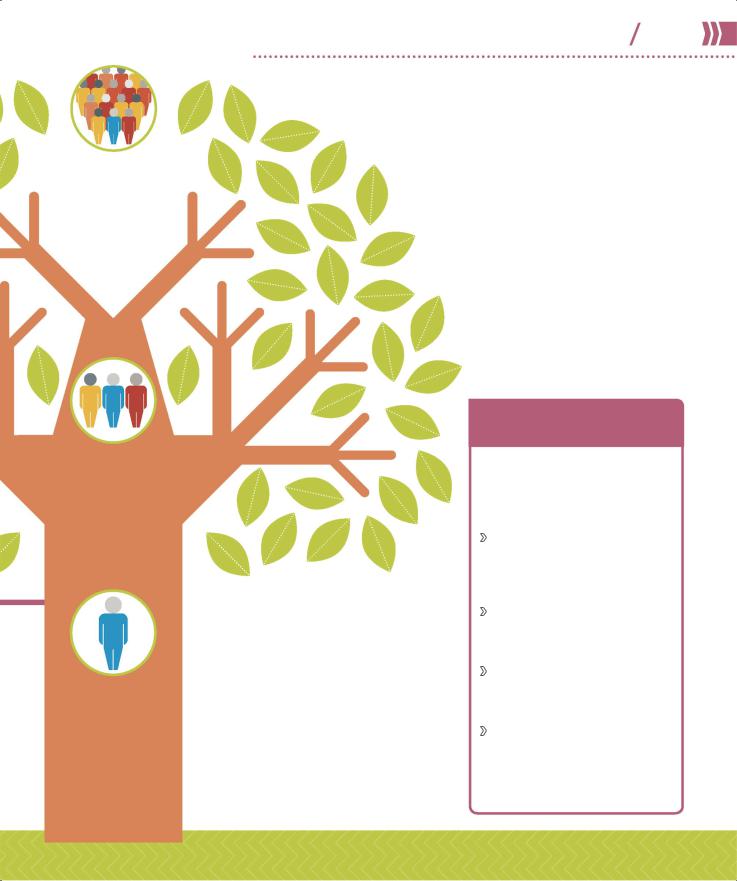
Empowerment of the community
Improves the quality of people’s collective access to government and community resources.
Empowerment of organizations
Improves the health and functioning of organizations, which is crucial to the health of communities and
societies overall.
Empowerment of the individual
Supports individuals in their interactions with organizations and their community.
PSYCHOLOGY IN THE REAL WORLD |
218 219 |
Psychology in the community |
80%
of homeless people in the UK report mental health issues
How does it work?
Psychologists empower across two levels. First-order change tackles social issues at the microscopic level— helping individual lives as a way of fixing a larger problem (such as making it easier for people who have suffered discrimination to file a complaint).
Second-order change deals on a macroscopic level—addressing the systems, structures, and power relationships that contribute to the problem (for example, instituting anti-bullying laws). This type of change takes longer to implement and disrupts the status quo, often to wide-reaching positive effect.
TAKING ACTION
FOR WELL-BEING
Community-based organizations can use four strength-oriented principles (known as SPEC) to guide their actions and decisions, and to promote positive change in the community:
Strength Acknowledging the strengths of individuals and of communities helps people to thrive, whereas focusing on weaknesses strips them of dignity.
Prevention Preventing healthrelated, social, and psychological problems is more effective than solving established problems.
Empowering Giving people power, control, influence, and choices helps them to achieve individual and community well-being.
Community change Improving the conditions that initially created the problems brings about real change; it is not enough to change each individual problem.
Mental Health Foundation
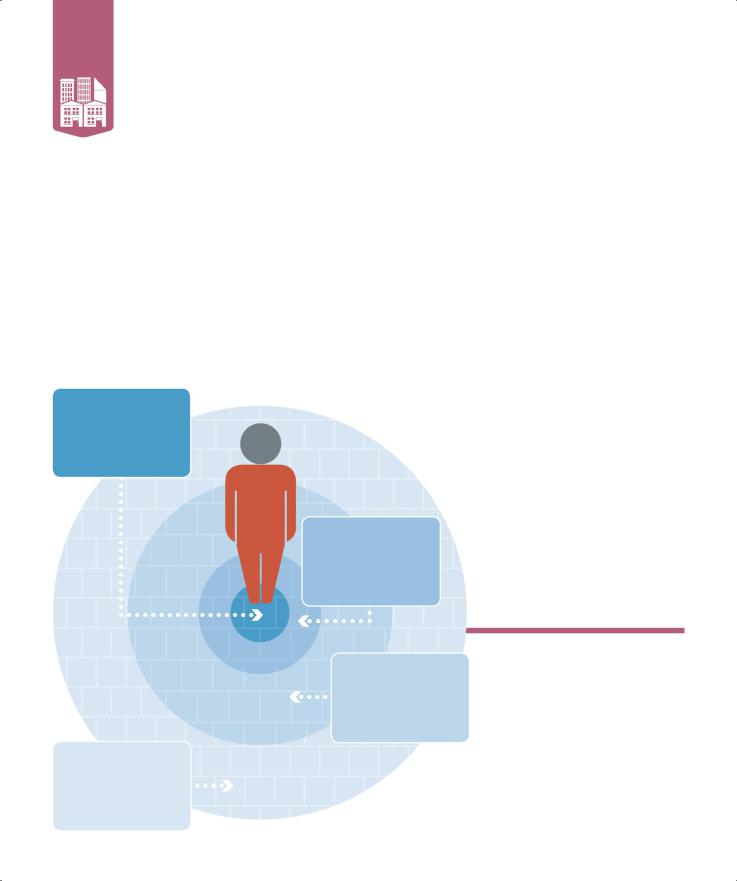
Urban communities
Environmental psychology looks at people’s behavior in relation to their surroundings, including open spaces, public and private buildings, and social settings.
Why place affects people |
physical environments that could |
For instance, children tend to |
Psychologist Harold Proshansky |
promote success and well-being. |
behave differently at home, at |
was among the first to hypothesize |
Research in environmental |
school, and on the playground, |
that people are fundamentally |
psychology has indeed shown that |
adjusting their level of energy to |
shaped by their environment. He |
environment plays a critical role in |
match the environment. Research |
believed that understanding the |
a person’s psychology, that people |
has also shown that people can |
direct and predictable effects of |
identify strongly with the notion |
concentrate better indoors when |
surroundings would allow people |
of place, and that their behavior |
they can see the world outdoors, |
to seek out, design, and build |
changes to match the setting. |
and that they are more comfortable |
INTIMATE SPACE 1½ FT (0.45 M)
Reserved for people’s closest relationships, such tight proximity allows for whispering and embracing.
PUBLIC SPACE
25 FT (7.6 M)
The distance used for public speaking, this space allows for communication but not interaction.
PERSONAL SPACE 4 FT (1.2 M)
Reserved for good friends and family, this close space must feel comfortable and allows for quiet talking.
SOCIAL SPACE
12 FT (3.6 M)
Used with acquaintances and coworkers, this level of proximity allows for interaction but no intimacy.
70%
of people in the world will live in urban communities by 2050
World Health Organization
Space
Cross-cultural anthropologist Edward T. Hall developed the theory of “proxemics,” which describes how people use space, and the effects of population density on behavior,
communication, and social interaction. He identified four interpersonal zones, which may vary among individuals according to their culture and age— spaces that are intimate, personal, social, and public.
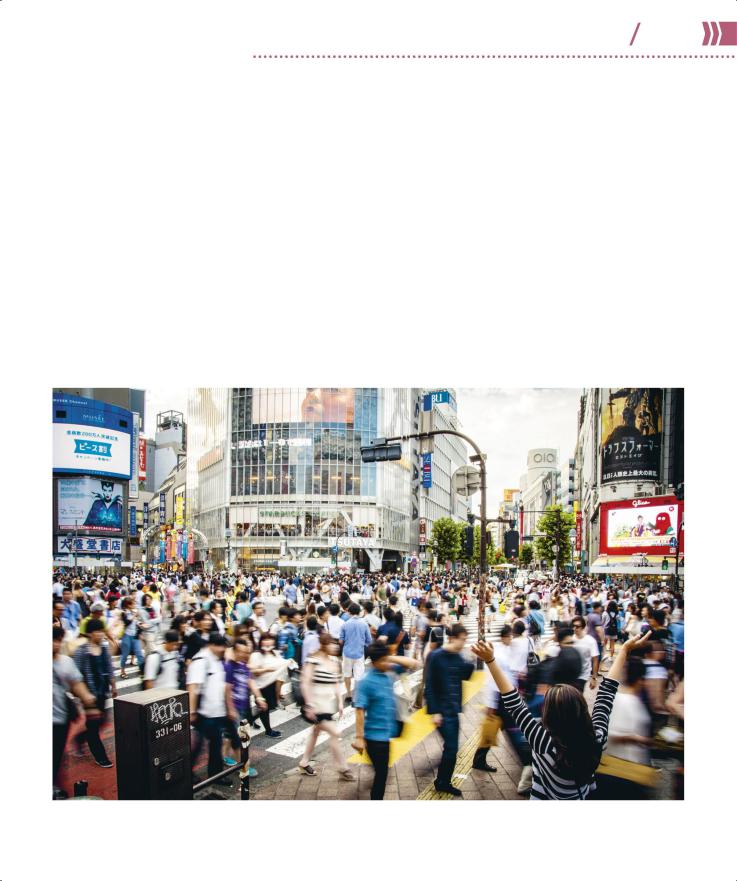
PSYCHOLOGY IN THE REAL WORLD |
220 221 |
Psychology in the community |
if they maintain some degree of personal space (below, left).
People’s mental, physical, and social health can suffer when their environment is blighted by issues such as crowding, noise, lack of natural light, decrepit housing, or urban decay. This is why the design of buildings and public spaces is so important to the overall health and well-being of individuals and societies. Architects, city planners, geographers, landscape architects, sociologists, and product designers all use environmental psychology to inform their vision of how people can improve their lives.
Crowding and density
Environmental psychologists make a distinction between the physical measurement of density (how many people are in a particular space) and crowding (the psychological feeling of not having enough space). Usually, high density is needed for the phenomenon of crowding, which makes people experience sensory overload, a lack of control, and rising stress and anxiety.
However, some psychologists see crowding as neutral rather than invariably negative, and believe that people’s moods and behaviors intensify as density increases. So if
an individual is looking forward to a concert, say, the feeling
of crowding enhances their enjoyment of the performance. But if they are dreading an event, crowding will make the person’s experience of it even worse.
Put into a community setting, crowding may accentuate
the dominant behavior—an aggressive group may turn violent as density rises. Conversely, creating positive social spaces such as parks and pedestrian areas in high-density urban environments may help to lift the general mood and defuse tension.
MODERN URBAN LIVING makes it difficult to maintain a comfortable level of personal space. High population densities lead to overcrowding on the streets, on public transport, and in offices and other buildings. One solution is careful environmental design.
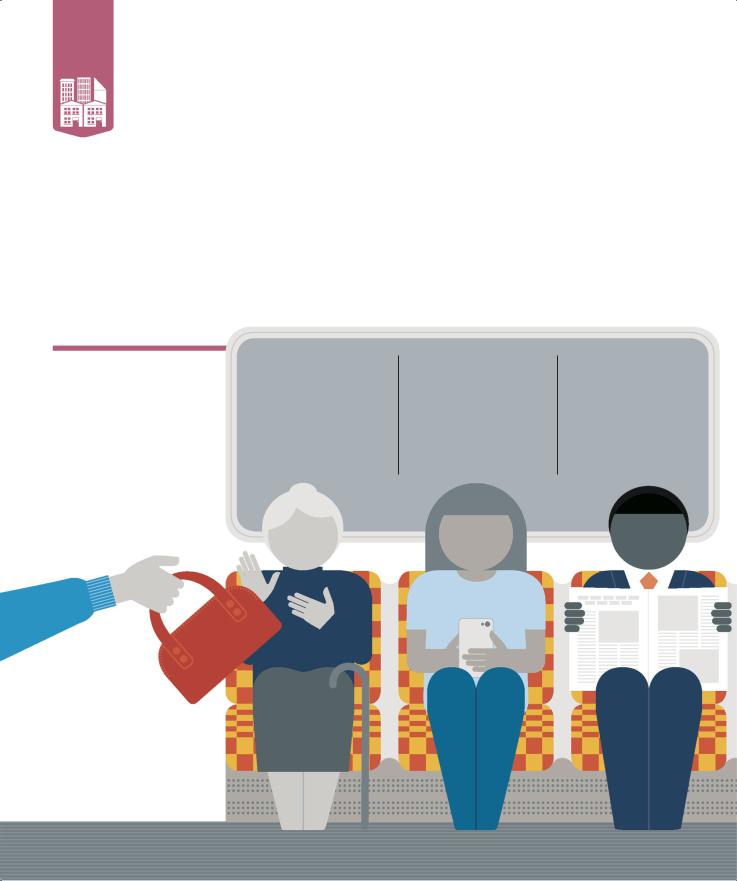
Safety in the community
Communities have many systems in place to keep their members physically and psychologically safe in the face of threats, both
in the real world and online.
Dealing with danger
In order for communities to flourish, individuals need to have an overall sense of physical and psychological safety. As well as causing physical damage and practical consequences, crime (such as burglaries,
murders, and cybercrime) can have a long-term psychological impact. People exposed to crime directly or indirectly may experience stress, fear, anxiety, sleep problems, a sense of vulnerability and helplessness, or extreme conditions like PTSD (p.62) and amnesia (p.89).
Bystander effect
People witnessing a crime are less likely to help victims if other witnesses are present. The more bystanders there are, the less likely it is that anyone will offer assistance. This inaction stems from the ways in which onlookers see or interpret the situation.
Level of emergency
A victim is less likely to be offered help when bystanders interpret the situation as an everyday matter rather than a serious one.
Ambiguity
In high-ambiguity situations, where people are unsure if a person requires help, they are slower to act than where the need for assistance is clear.
Environment
When bystanders are unfamiliar with the environment where a crisis occurs, they are less likely to offer help than if they are familiar.
How to prevent it
The bystander effect can be reversed by cues that raise public
self-awareness and remind people of their social reputation. Placing security cameras in public spaces can create these cues.
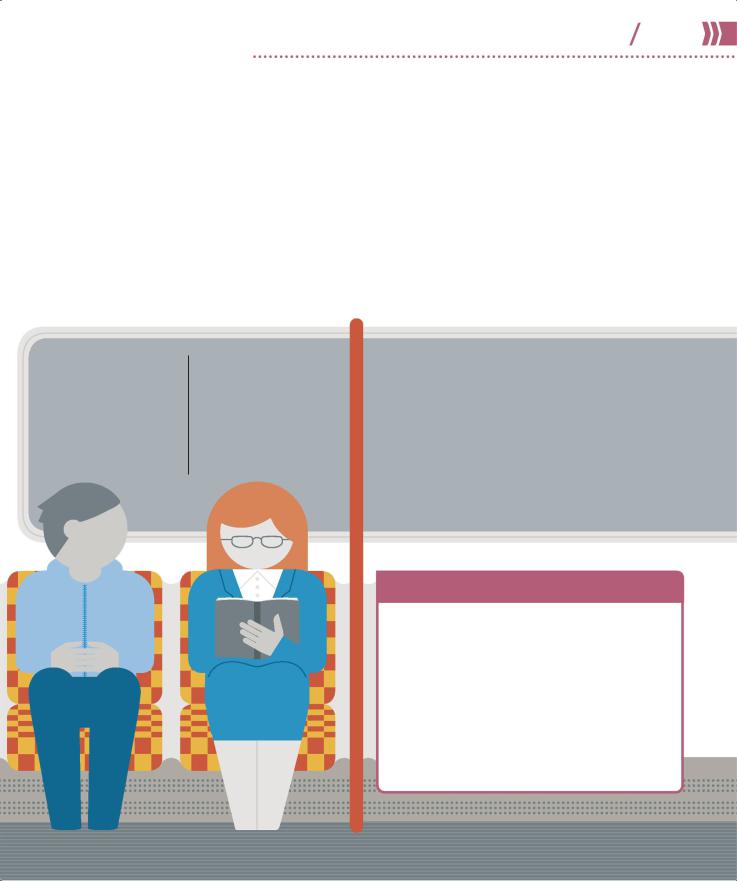
PSYCHOLOGY IN THE REAL WORLD |
222 223 |
Psychology in the community |
Communities implement many strategies to maintain order and to keep people safe. In cities, these measures may involve a focus on first responders (emergency medical teams, police, and firefighters), streamlining emergency communication and collaboration, clear road signage, and adequate street and park lighting.
A high priority within communities is protecting children, so there is often an emphasis on school safety. A safe environment is essential for learning, because prolonged stress impairs children’s cognitive ability. School safety can be increased by installing locking doors, adequate hallway lighting, and check-in systems for visitors and guests. However, extreme
measures, such as security cameras, metal detectors, and security guards, may actually increase fear, constantly reminding children of possible danger.
There is a growing trend for video surveillance in public places in an attempt to reduce crime. Although CCTV (closed-circuit television) cameras can help law enforcement officials to prevent crimes and quickly solve criminal cases, questions have been raised about the ethics and effectiveness of these cameras. Some criminologists have argued that cameras do not prevent most crimes and may provide a false sense
of security, causing people to take fewer precautions, thereby increasing their risk of becoming a victim.
Social cues
People look to each other for cues about how to behave in a situation. Inaction by some bystanders
will most likely lead to inaction by others.
Diffusion of responsibility
When several people witness a crime, they are less likely to help the victim because they expect someone else will take responsibility.
CASE STUDY: GENOVESE MURDER
Shortly after 3:00 a.m. on March 13, 1964, 28-year-old Kitty Genovese was murdered outside her apartment building in New York City. She was returning home from her bar shift when Winston Moseley attacked, stabbed, and raped her. The initial news reports stated that there were 38 witnesses to the attack—neighbors who stood by and did nothing to help Genovese. In the light of those reports of witness inaction, psychologists coined the term “Genovese syndrome” and began to study this social-psychological phenomenon, which has since become known as the “bystander effect” (left).
ONLINE COMMUNITIES
In the digital age, online communities and social networks are primary places where people fulfill their psychological needs for companionship, self-esteem, acceptance, and belonging. However, virtual connection can also present dangers. The sense of anonymity
and invisibility can encourage people to say and do things online that they would not do in person. This is known as the “disinhibition effect,” which can result in hate speech, cyberbullying, trolling, and grooming. Learning how to stay safe online is therefore essential, especially for vulnerable populations such as children.
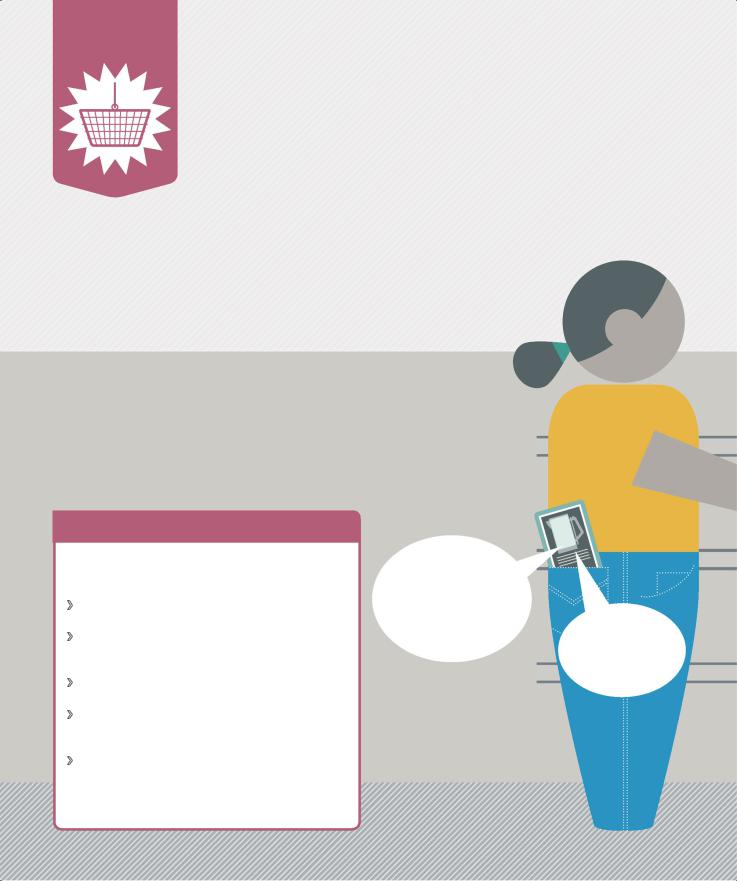
Consumer psychology
The study of customers and how they behave—what they want, what they need, and the factors that influence their buying habits and choices—is called consumer psychology. From the essentials of food, shelter, and clothing to common luxuries such as smartphones and cars,
people are constantly making decisions about what products and services to buy and from whom.
What drives consumer behavior
There are numerous factors that influence consumer choice: cost, brand, accessibility, shipping times, a product’s shelf life,
the shopper’s mood, packaging, and endorsement. Businesses strive to understand their customers’ needs and motivations so that they present their products and services in a way that appeals to them directly. Manipulating even tiny details can sway attitudes and persuade people to purchase a company’s products.
ADVERTISING POWER
Consumer psychology plays a large role in making advertising memorable as people today are bombarded with advertisements both offline and online.
Traditional approach Bright colors and catchy jingles are still effective and popular in TV advertising.
Shared knowledge Drawing on shared representations of society, such as referring to a popular television show, involves the audience.
Graphic design In newspaper and magazine ads, the layout, use of contrast, and style of lettering are critical.
Humor Making people laugh avoids viewer boredom and helps to fix the name of a product in the mind, making all the difference to which brand is chosen.
Consumer input Ironically, not mentioning the name can be effective, as cognitive psychology shows that people remember things better if they have to work them out rather than passively absorbing.
Personal recommendations
People like to buy products that their friends and role models are using.
Reviews
Consumers read customer reviews to help decide what to buy.
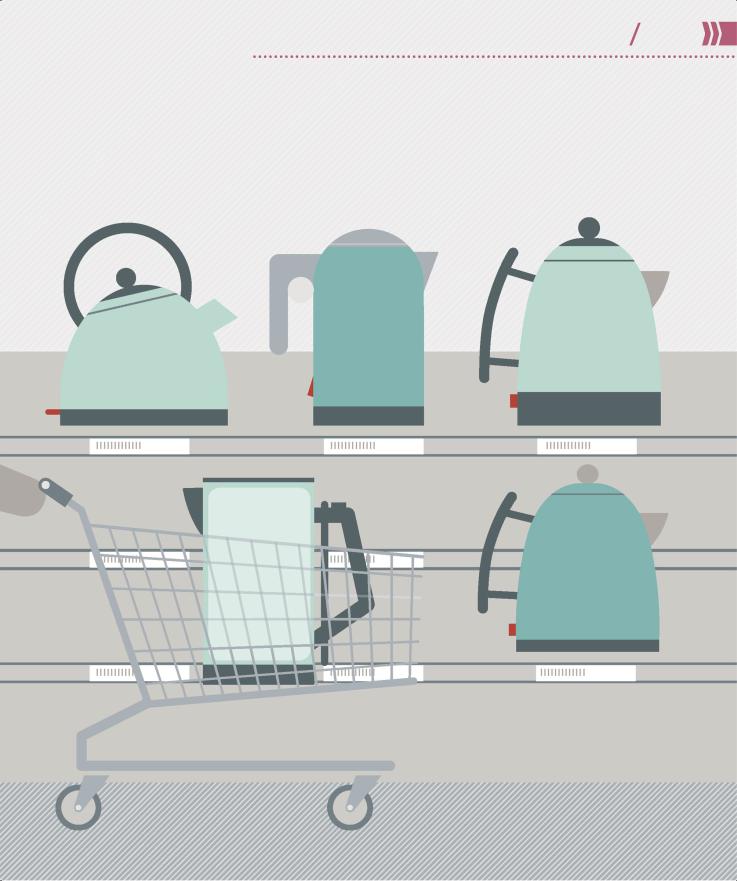
PSYCHOLOGY IN THE REAL WORLD |
224 225 |
Consumer psychology |
“Knowing who your customers are is great, but knowing how they behave is even better.”
Jon Miller, American marketing entrepreneur
Brand information
Consumers want to know what is in it for them if they buy a product.
Past experience
People are driven by positive past experiences so familiarity with a brand goes
a long way.
Trust
Buyers need to be confident that a company will deliver on its promises and keep their personal data and bank details safe.
Promotions
Consumers are attracted by promotions, especially if they perceive greater value for money.
Pricing
Consumers buy when prices are at an affordable level that gives value for money. Careful pricing ultimately increases sales.
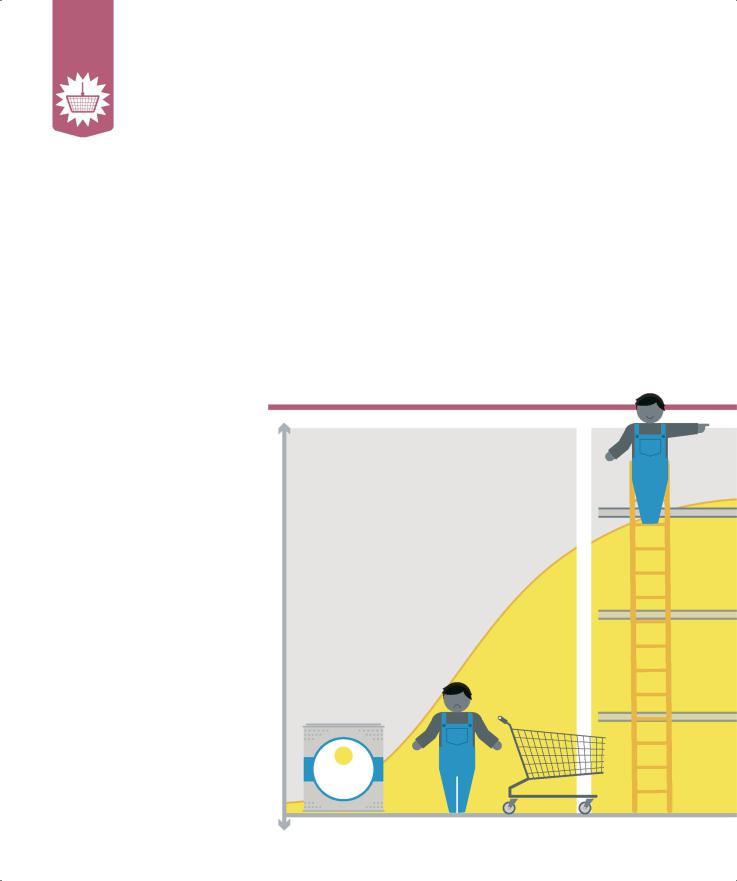
Understanding consumer behavior
Understanding how people make decisions about what they want, need, and buy is essential to successful marketing because it helps companies to predict how consumers will respond to new products.
Deciding what to buy
Consumer behavior is affected
by psychological factors, such as a person’s perception of what they need, their attitude, and their ability to learn; personal characteristics—someone’s habits, interests, opinions, and style of decision-making—and social considerations, including family, work colleagues or school friends, and group affiliations.
Companies collect and analyze data on such behavior from focus groups and online sources such as customer reviews, question-and- answer websites, surveys, keyword research, search engine analysis and trends, blog comments, social media, and government statistics.
How people decide which options will bring them the greatest
present and future satisfaction is called consumer prediction. It has two dimensions: the utility of a future event (how much pleasure or pain a person will get, for example, from a trip to Paris rather than a break in New York, or whether they would get more pleasure from eating chocolate or celery) and how likely that event is to occur.
Emotional response
Emotions are a huge factor in consumer behavior and decisions. They affect what consumers focus on, what they remember, how they process information, and how they predict they will feel after making a decision. Feelings override reason when evaluating advertisements, and produce faster and more
EMOTION |
The paradox of choice |
|
Consumers prefer to have choice, but not too |
||
|
||
POSITIVE |
much. In a study from the year 2000, when |
|
faced with only 6 kinds of jam, 30 percent made |
||
|
shoppers had a choice of 24 kinds of jam, just |
|
|
3 percent of them bought any. But of those |
|
|
a purchase. The same applies whatever the |
|
|
product, from legal services to paint. |
“Once you understand customer behavior, everything else falls into place.”
Thomas G. Stemberg, American philanthropist and businessman
NEGATIVE EMOTION
Negative emotion
When there is no choice, consumers feel they have no control or say in the matter and lose the motivation
to make a purchase.
YELLOW |
No choice |
PAINT |
can be |
|
bad. |
NUMBER OF CHOICES
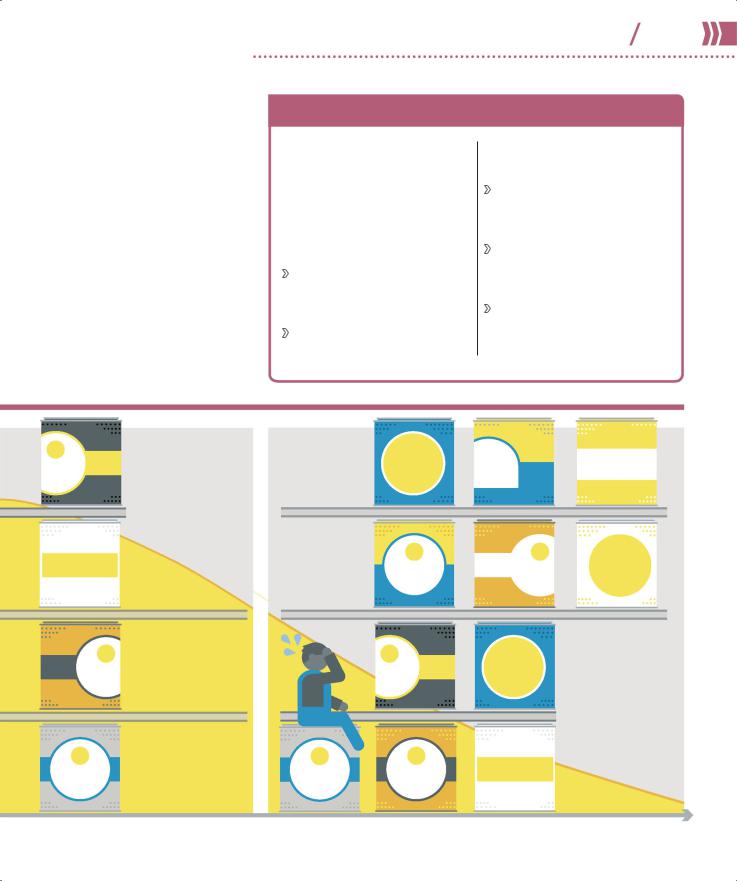
consistent judgments. Companies constantly try to glean emotional reactions to their products from prospective consumers, as positive and negative emotions are present at every step of the buying process, from searching to evaluating to choosing to consuming and, finally, to disposing of a product.
Companies evaluate valence (how positive or negative the emotion is) and arousal (how worked up the consumer is) in as much detail as possible. Cognitive appraisal analyzes what and how consumers think about their feelings. All contribute to how ready a consumer is to take action.
ELLOW
PAINT
YELLOW
PAINT
Positive emotion
Seeing the difference between options gives consumers a sense of freedom and power to make their own
informed decision.
Limited choice may be best.
YELLO
PAINT
YELLOW
PAINT
PSYCHOLOGY IN THE REAL WORLD |
226 227 |
Consumer psychology |
CUSTOMER PROFILING
Marketers create detailed portraits of their customers’ buying habits, preferences, and lifestyles from their own data and use external sources to help predict future consumer behavior and promote effectively. They use a number of variables to build up a detailed profile of their target market.
Psychographic Personality; positive or negative attitude toward life; ethic—whether someone works hard or gives to charity, for example
Behavioral Preferred shopping location, online and offline;
frequency of purchases; typical expenditure; credit-card usage; degree of loyalty to a brand
Sociographic Use of social media; level of activity in community; political views; membership in groups and clubs
Geographic Continent lived in; city or countryside; zip code; associated work and social opportunities; climate
Demographic Age group; partner status; number of children, if any; nationality; ethnic background; religion; occupation; salary
YELLOW |
ELLOW |
YELLOW PAINT |
|
PAINT |
PAINT |
||
|
|
YELLOW |
YELLO |
YELLOW |
|
PAINT |
||
Too much choice |
PAINT |
PAINT |
|
can be bad. |
|
|
|
|
|
|
Negative emotion |
|
|
YELLOW |
Excessive choice |
|
ELLOW |
overwhelms |
|
|
PAINT |
||
|
PAINT |
shoppers and leaves |
|
|
|
||
|
|
|
them dissatisfied, |
|
|
|
fearful that there is |
|
|
|
a better option than |
|
|
|
the one they have |
|
|
YELLOW |
selected. |
YELLOW |
YELLOW |
|
|
PAINT |
|
||
PAINT |
PAINT |
|
|
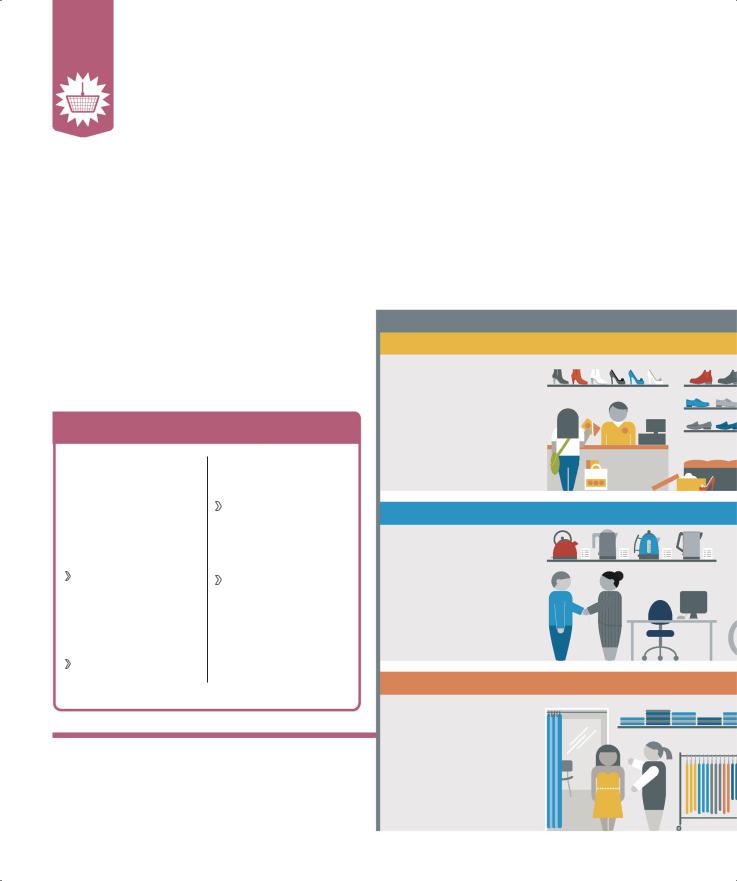
Changing consumer behavior
A company’s success depends on how well it sells its products to consumers, and that requires persuasion. At the heart of effective persuasion is the ability to change people’s attitudes.
Attitudes and persuasion
In order to persuade the public to buy their products, companies need to influence attitudes—the evaluations people form about ideas, objects, and other people. Consumer psychologists are interested in how attitudes can be shaped, and in how potential customers respond to persuasion.
Attitudes can be a core driver of consumer behavior. They affect whether a consumer makes a purchase now or later, spends more or less money, or chooses
THE GOLDEN RULES OF MARKETING
The Internet has revitalized marketing, providing advertisers with a new and expanding reach. But the heart of good marketing remains the same: product, price, promotion, and place.
Product Whether tangible goods or an intangible service, the product must fulfill a customer’s wants or needs and benefit them.
Price Supply, demand, profit margins, and
marketing strategy all rest on price. Even minor tweaks affect returns.
Promotion
Communicating relevant product information well to customers is known to promote sales.
Place Finding the ideal selling place converts potential clients into real clients. SEO (search engine optimization) is a way of improving search engine rankings and so helps online business.
The power of persuasion
There are six principles of persuasive marketing that retailers and other businesses make full use of.
Even if people resist persuasion initially, their attitude and behavior may be more open to change over time.
one product over another. How much consumers like or dislike a product, brand, or company reflects their attitudes—positive, neutral, or negative. The longer an attitude has lasted and the stronger it is, the more
Commitment
People feel they are part of a community when companies give them
a say in the product or service—for example, issuing a membership card that offers discounts—and are more likely to buy.
Authority
Customers want to believe in leaders and salespeople. They look for credentials and experience, and prefer to buy from someone who evidently knows their product, and can sell them the most suitable type.
Liking
People are more inclined to buy from those who like, compliment, or appreciate them. Expressing approval (“That dress looks great
on you!”) encourages a potential buyer to spend money with that company.
